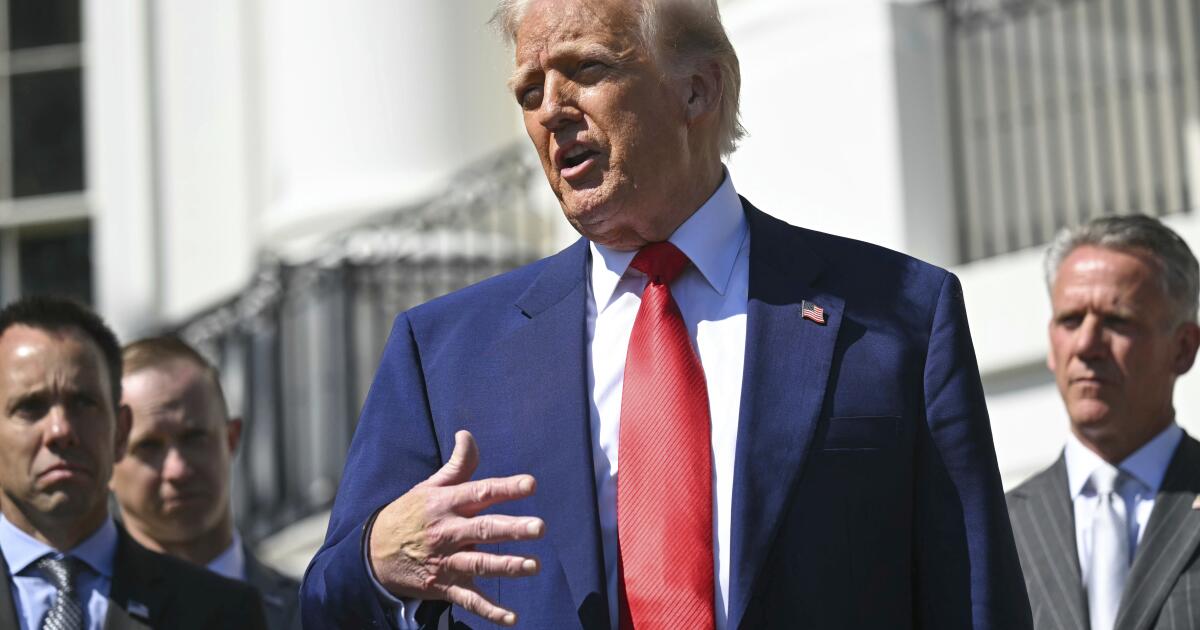
WASHINGTON — President Trump walked back plans on Wednesday for a global trade war that sparked fears of economic panic and recession, a dramatic reversal after a week of market turmoil that led to a historic surge of relief on Wall Street.
But the president further escalated his standoff with China over tariffs, raising duties on America’s third-largest trading partner to 125%. Trump’s tariff on foreign automobiles, set at 25%, remains in place.
Markets responded to Trump’s reversal with an exuberant surge, a turn of fortunes after news of the president’s policies last week wiped out $7 trillion in value over just three days of trading. Overnight, a U.S. bond market selloff added to concerns over a spiraling economic crisis.
Minutes after Trump changed course, the Dow Jones industrial average rose over 2,900 points. The Nasdaq was up 12% at the closing bell. And the Standard & Poor’s 500 increased over 9.5% — its largest gain since the 2008 financial crisis, but still down over 11% from its February highs.
The turnabout provided temporary relief from a policy that experts warned could upend the global economy, sending prices in the United States up across the board and risking global recession.
Trump administration officials initially explained the policy switch as part of an organized plan: “This was his strategy all along,” Treasury Secretary Scott Bessent said. Yet, within the hour, Trump himself acknowledged that dire market blowback from his announcement last week forced him to back down.
The initial policy plan had countries paying a universal tariff of 10% to import their goods to the United States. Other, select countries, which the president believed were treating the United States unfairly, were hit with higher rates.
“I thought that people were jumping a little bit out of line,” Trump told reporters at the White House, explaining his decision. “They were getting yippy, you know, they were getting a little bit yippy, a little bit afraid.
“I guess they say it was the biggest day in financial history,” Trump added. “I think the word would be flexible, you have to be flexible.”
The sequencing of Trump’s announcement prompted some concern among Democrats that Trump may have tipped off allies that a policy reversal was coming. On Wednesday morning, four hours before announcing the pause, Trump wrote on social media that it was a “GREAT TIME TO BUY.”
“Trump is creating giant market fluctuations with his on-again, off-again tariffs. These constant gyrations in policy provide dangerous opportunities for insider trading,” said Sen. Adam Schiff (D-Calif.). “Who in the administration knew about Trump’s latest tariff flip-flop ahead of time? Did anyone buy or sell stocks, and profit at the public’s expense? I’m writing to the White House — the public has a right to know.”
Trump said he would pause his universal 10% tariff rate on most countries, which went into effect a week ago.
But other trading partners hit with higher rates on Wednesday — tariffs that were referred to as “reciprocal” by the White House, but that actually reflected a country’s trade deficit with the United States — will now have those rates lowered to 10%.
While Trump said that rate is “substantially lower” than previously planned rates, it is still nearly three times the average import tax that had been in place before his announcement last week.
China, meanwhile, will be hit by yet another increase in duties, with imports from Beijing now facing a 125% tariff rate, after China matched Trump’s last two rate hikes over the past week.
“Based on the lack of respect that China has shown to the World’s Markets, I am hereby raising the Tariff charged to China by the United States of America to 125%, effective immediately. At some point, hopefully in the near future, China will realize that the days of ripping off the U.S.A., and other Countries, is no longer sustainable or acceptable,” Trump wrote on Truth Social, leading markets to soar minutes later.
“Conversely, and based on the fact that more than 75 Countries have called … to negotiate a solution to the subjects being discussed relative to Trade, Trade Barriers, Tariffs, Currency Manipulation, and Non Monetary Tariffs, and that these Countries have not, at my strong suggestion, retaliated in any way, shape, or form against the United States,” Trump continued, “I have authorized a 90 day PAUSE, and a substantially lowered Reciprocal Tariff during this period, of 10%, also effective immediately. Thank you for your attention to this matter!”
The president’s decision to reverse course drew widespread praise from his political allies, who credited him with executing on the “art of the deal” over the past week.
Trump’s approach, wrote Bill Ackman, a billionaire hedge fund manager and supporter of the president, is that “we now understand who are our preferred trading partners, and who the problems are. China has shown themselves to be a bad actor.”
Bessent initially told reporters at the White House that Trump’s decision to issue a pause was the result of most countries around the world refraining from issuing retaliatory measures, and instead approaching the administration with offers to negotiate.
“President Trump created maximum negotiating leverage for himself,” Bessent said. “The ones that we have lowered went into effect a week ago, and we have just been overwhelmed — overwhelmed — by the responses from, mostly, our allies, who want to come and negotiate in good faith.”
Karoline Leavitt, the White House press secretary, pushed back against questions from the media over the president backing down in the face of market pressures, as well as assessments from the country’s major banking institutions, such as JPMorgan Chase and Goldman Sachs, that his new trade policy would push the country into recession.
“Many of you in the media clearly missed the art of the deal,” Leavitt said. “You clearly failed to see what President Trump is doing here.”
The White House said Trump was providing relief to trading partners that declined to retaliate to his initial tariff increase, and was escalating with China because it took retaliatory steps.
But Trump found out that the European Union, too, announced plans to retaliate with new levies only on Wednesday morning, when questioned by a reporter in the Oval Office that afternoon.
Howard Lutnick, the Commerce secretary, told Trump in front of reporters that he did not believe Europe’s new actions would go into effect.
“Oh, that’s bad timing for them. That’s bad timing,” Trump said.
“They didn’t put them in,” Lutnick said. “No, they threatened. But they picked a later date, which, our expectation is it’s going to be later still.”
“Oh, OK. Because I’m glad that they held back,” Trump responded.
Trump and Leavitt had denied for days that Trump would consider any pause on the new trade policy, even denying that the specific pause announced Wednesday — a 90-day pause on global tariffs, with China excluded — was on the table just two days ago.
That rumor led to a short-lived market rally on Monday before the White House referred to such plans as “fake news,” plunging stocks once more.
“We are not looking at that,” Trump told reporters at the time, asked about the prospects of a 90-day pause.
By Wednesday, Trump said of the pause, “it’s something very positive for the world.”



